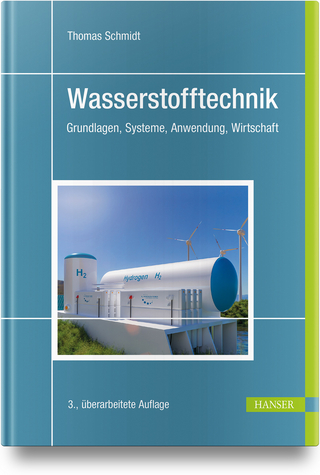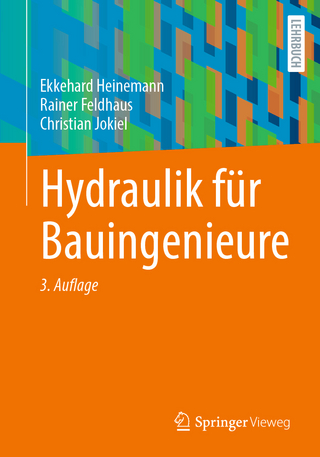
Integrated Drought Management, Volume 2
CRC Press (Verlag)
978-1-032-23168-6 (ISBN)
The second volume of this comprehensive global perspective on Integrated Drought Management is focused on drought modeling, meteorological prediction, and the use of remote sensing in assessing, analyzing, and monitoring drought. It discusses risk management, planning, policy, and societal impacts of drought such as water pricing, water transfer, water quality, and crop insurance. Through numerous case studies from India, Iran, Brazil, the US, Nepal, and other countries that cover a broad range of topics and geographical regions, this volume serves as a valuable resource for all professionals, researchers, and academics who want to advance their knowledge about droughts.
Features
Provides a global perspective on drought prediction and management and a synthesis of the recent state of knowledge.
Covers a wide range of topics from essential concepts and advanced techniques for forecasting and modeling drought to societal impacts, consequences, and planning
Presents numerous case studies with different management approaches from different regions and countries.
Addresses how climate change impacts drought, the increasing challenges associated with managing drought, decision-making, and policy implications.
Includes contributions from hundreds of experts from around the world.
Professionals, researchers, academics, and postgraduate students with knowledge in environmental sciences, ecology, agriculture, forestry, hydrology, water resources engineering, and earth sciences, as well as those interested in how climate change impacts drought management, will gain new insights from the experts featured in this two-volume handbook.
Vijay P. Singh, PhD, DSc, is a University Distinguished Professor, a Regents Professor, and Caroline and William N. Lehrer Distinguished Chair in Water Engineering at Texas A&M University, USA. He earned his BS, MS, PhD and DSc degrees in engineering. He is a registered professional engineer, a registered professional hydrologist, and an honorary diplomat of ASCE-AAWRE. He is a distinguished member of ASCE, an Honorary Member of IWRA, a Distinguished Fellow of AGGS, and an Honorary Member of AWRA, and a fellow of EWRI-ASCE, IAH, ISAE, IWRS, and IASWC. He has published extensively in the areas of hydrology, irrigation engineering, hydraulics, groundwater, water quality, and water resources with more than 1370 journal articles; 32 textbooks; 75 edited reference books, including Handbook of Applied Hydrology and Encyclopedia of Snow, Ice and Glaciers; 115 book chapters; and 315 conference papers. He has received more than 100 national and international awards, including three honorary doctorates. He is a member of 12 international science/engineering academies. He has served as President of the American Institute of Hydrology (AIH); President of American Academy of Water Resources Engineers; President of International Association for Water, Environment, Energy, and Society; and Chair of Watershed Council of American Society of Civil Engineers. He has served as editor-in-chief of five journals and two book series and serves on editorial boards of more than 25 journals and three book series. His Google Scholar citations are 72,000; h-index of 119; and I10-index of 1025. Deepak Jhajharia, PhD, is currently working as Professor in Department of Soil & Water Conservation Engineering, College of Agricultural Engineering & Post Harvest Technology (Central Agricultural University), Ranipool, Gangtok, Sikkim, India. He is also acting as principal investigator of All India Coordinated Research Project on Plastic Engineering in Agriculture Structures and Environment Management (CAEPHT Centre) funded by Indian Council of Agricultural Research-Central Institute of Post Harvest Engineering and Technology, Ludhiana, Punjab, India. He studied Agricultural Engineering, graduating in 1998 from the College of Technology and Engineering (MPUAT), Udaipur, Rajasthan, India, and completed his postgrad studies in Water Resources Engineering from Department of Civil Engineering at the Indian Institute of Technology, Delhi, India. He earned his PhD from the Department of Hydrology, Indian Institute of Technology, Roorkee, Uttarakhand, India. Prof. Jhajharia is the recipient of the prestigious Science Without Borders scholarship - Young Talent of CNPq (Brazil) as Research Collaborator at the Department of Agronomy, Universidade Federal Rural De Pernambuco (UFRPE), Ministry of Education, Brazil. He has 22 years of academic experience and has published more than 85 papers in peer-reviewed journals, books, reports or extension bulletins. He has guided one PhD and 13 MTech theses in the field of Soil and Water Conservation Engineering along with many undergraduate theses in the field of Agricultural Engineering. He is co-editor of Agricultural Impacts of Climate Change and Applied Agricultural Practices for Mitigating Climate Change published by CRC Press/Taylor & Francis Group. He also conducted 21-day Summer School for scientists from ICAR and faculty members from different universities of India and one 90-day skill development training programme on Greenhouse Technology for school drop-outs and unemployed rural youth from six states of northeast India. He was awarded the CSIRO Land and Water Publication Award 2013, CSIRO Australia for global review paper published in Journal of Hydrology. He was also adjudged the best extension scientist (2017-18) of the AICRP on PET in recognition of outstanding contribution for extension and popularization of Plasticulture Technologies in Sikkim. He is recipient of Distinguished Alumni Award (in 2016) by College of Technology and Engineering Alumni Society, CTAE (MPUAT), Udaipur. Prof. Jhajharia was elected as the Fellow of Indian Association of Hydrologists, Roorkee (in 2015) and Indian Water Resources Society, Roorkee (2019). He is also a life member of 14 different professional societies from India and abroad. His Google Scholar citations are 3042 and h-index of 18. Rasoul Mirabbasi, PhD, is an Associate Professor of Hydrology and Water Resources Engineering at Shahrekord University, Iran. He is also Head of the Water Resources Center of Shahrekord University. His research focuses mainly on Statistical and Environmental Hydrology and Climate Change. In particular, he is working on Modeling Natural Hazards including Flood, Drought, Wind, and Pollution toward a sustainable environment. Formerly, he was a Visiting Researcher at the University of Connecticut, USA. He has contributed to more than 150 publications in journals, books, or technical reports. Dr. Mirabbasi is the reviewer of about 30 Web of Science (ISI) Journals. His Google Scholar citations are 1916 and h-index of 22. Rohitashw Kumar, PhD, is a Professor at the College of Agricultural Engineering and Technology, She-e- Kashmir University of Agricultural Sciences and Technology of Kashmir, Srinagar, India. He is also holding the additional charge of Associate Dean, College of Agricultural Engineering and Technology and SKUAST- Kashmir, Srinagar (India). He is also Professor Water Chair (Sheikkul Alam Shiekh Nuruddin Water Chair), Ministry of Water Resources, Government of India, at the National Institute of Technology, Srinagar (J&K). He earned his PhD in Water Resources Engineering from NIT, Hamirpur and Master's of Engineering in Irrigation Water Management Engineering from MPUAT, Udaipur. He received the Special Research Award in 2017 and Student Incentive Award-2015 (PhD Research) from Soil Conservation Society of India, New Delhi. He won first prize in India for best MTech thesis in Agricultural Engineering in 2001. He graduated from Maharana Pratap University of Agriculture and Technology, Udaipur, India, in Agricultural Engineering. He has published more than 80 papers in peer-reviewed journals, four practical manuals and 20 chapters in books. He has guided ten post-graduate students in soil and water engineering. He has handled more than ten research projects as a principal or co-principal investigator. Since 2011, he has been Principal Investigator of All India Coordinated Research Project on Plastic Engineering in Agriculture Structures and Environment Management (Srinagar Centre) funded by Indian Council of Agricultural Research, Central Institute of Post Harvest Engineering and Technology, Ludhiana, Punjab, India. His Google Scholar citations are 1148 and h-index of 18.
1. Spatial and temporal linkages between large‐scale atmospheric oscillations and hydrologic drought indices in Turkey 2.Spatio-temporal drought analysis 3.Analysis of spatial variability and patterns of drought: A case study for Serbia 4. Spatial and temporal trend pattern of drought in Bangladesh in the past four decades 5. Spatio-Temporal Analysis of Meteorological Drought in Tripura, Northeast India 6.Drought assessments in the non-stationary domain 7. Drought monitoring in Arid and Semiarid environments using Aridity Indices (AI) and Artificial Neural Network (ANN) 8.Soil moisture drought estimation using hydrological modelling approach for a river basin of Eastern India 9. Meteorological Drought Prediction Using Hybrid Machine Learning Models: Ant Lion Optimizer Vs Multi-Verse Optimizer 10. Uncertainty Analysis of Bivariate Modeling of Hydrological Drought Severity and Duration Using Copula 11. Copula based Bivariate Frequency analysis of Drought Characteristics over India 12. Application of Fuzzy Rule Base Model for Forecasting Drought 13. A copula-based joint deficit index for the analysis of droughts in New Zealand 14. Comparative copula‐based multivariate meteorological drought analysis: a case study from Northeast India 15. Multivariate Assessment of Drought Using Composite Drought Index 16. A multi-model ensemble based drought characterization over India for 21st century 17. Drought Characteristics and Forecasting Under Climate Change Conditions: a case study of Indonesia 18. Stochastic Modelling of Water Deficit over Different Agro-climatic Zones of Karnataka 19. The tree-ring-based drought and flood analyses from the Himalayan region: Limitations, Challenges, and Future Perspectives 20. Remote sensing capabilities for observational drought assessme 21. Four decades of satellite data for agricultural drought monitoring throughout the growing season in Central Chile 22. Application of multi-source data for drought monitoring and assessment over the Yellow River Basin, China 23. Analysis of Agricultural Drought in Southwest Iran using Remote Sensing indices 24. Soil Moisture-Vegetation Stress-based Agricultural Drought Index Integrating Remote Sensing Derived Soil Moisture and Vegetation Indices 25. Application of drought monitoring tools for wildfire hazard assessment in forests of India 26. Hydrological Drought Impacts on River Water Quality of Peninsular River System, Tunga-Bhadra River, India 27. Integrated Drought Management: Moving from Managing Disasters to Managing Risk 28. Is India Ready to Account for Ecological Droughts? 29. Water Transfer 3. A Compact Policy to Combat Water Scarcity 31. Water Pricing focusing Drought Conditions 32. Incorporating ecosystem services into drought planning: Lessons from two place-based applications from the US West 33.Drought tolerance agronomic management strategies for rainfed and irrigated maize crop in Eastern India 34. Life despite drought in the Brazilian semiarid 35. Gender Responsive Solutions for Managing Drought in the Hindu Kush Himalaya 36. Conventional and Advanced Irrigation Scheduling Techniques to mitigate drought 37. Water Resources, Uses and its Integrated Management in the United Arab Emirates 38. Droughts, distress, impact, and mitigation: case study of Jammu and Kashmir 39. Different in-situ moisture conservation options in rainfed agro-ecologies of Odisha
| Erscheinungsdatum | 14.09.2023 |
|---|---|
| Reihe/Serie | Drought and Water Crises |
| Zusatzinfo | 159 Tables, black and white; 7 Line drawings, color; 40 Line drawings, black and white; 140 Halftones, color; 122 Halftones, black and white; 147 Illustrations, color; 162 Illustrations, black and white |
| Verlagsort | London |
| Sprache | englisch |
| Maße | 178 x 254 mm |
| Gewicht | 453 g |
| Themenwelt | Naturwissenschaften ► Biologie ► Ökologie / Naturschutz |
| Naturwissenschaften ► Geowissenschaften ► Geografie / Kartografie | |
| Naturwissenschaften ► Geowissenschaften ► Meteorologie / Klimatologie | |
| Naturwissenschaften ► Physik / Astronomie ► Angewandte Physik | |
| Technik ► Bauwesen | |
| Technik ► Umwelttechnik / Biotechnologie | |
| ISBN-10 | 1-032-23168-8 / 1032231688 |
| ISBN-13 | 978-1-032-23168-6 / 9781032231686 |
| Zustand | Neuware |
| Informationen gemäß Produktsicherheitsverordnung (GPSR) | |
| Haben Sie eine Frage zum Produkt? |
aus dem Bereich


